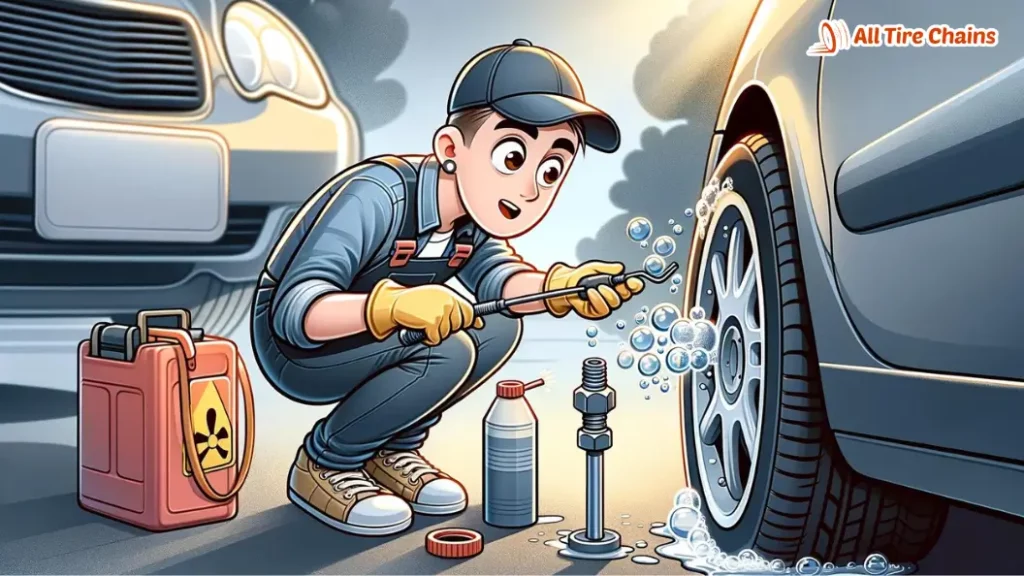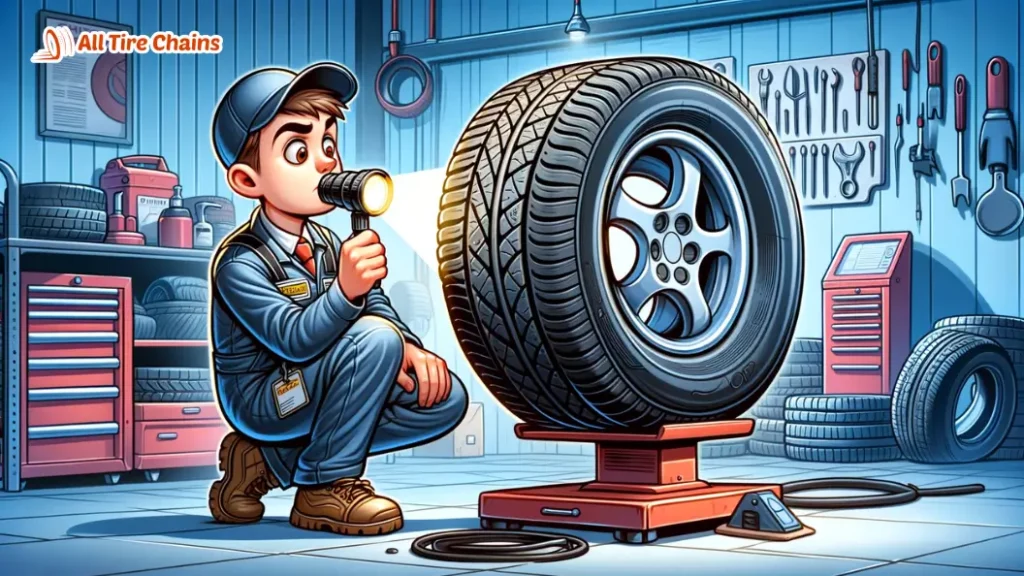If you’ve found yourself asking, “Why is my tire losing air overnight?” you’re not alone. This common issue plagues many vehicle owners, leaving them befuddled and frustrated. Our comprehensive guide aims to provide clarity. From highlighting potential causes to offering practical solutions, we’ll navigate this problem together. So, fasten your seat belts because this journey toward tire enlightenment is about to begin.
Find your tire flat in the morning? Frustrating, right? Many car owners face this mystery. We’ll help you understand why your tire loses air overnight.

Possible reasons include:
- Puncture or damage to the tire. Small nails or screws embedded in the tread could be the culprit.
- Faulty valve stem could also lead to air leakage.
- Rim leaks or corrosion around the bead area are additional causes.
A fun fact: Robert William Thomson invented the first practical pneumatic tire design in 1845. Before his invention, solid rubber tires were used on carriages and bicycles. These tires were uncomfortable but Thomson’s pneumatic design revolutionized the automotive industry! Smoother ride for vehicles!
Possible Reasons for a Tire Losing Air Overnight
Losing tire air overnight can be a pain. Knowing the possible causes helps fix it. One cause might be a leaky valve stem or a damaged valve core. These parts keep the tire and rim sealed. When they’re faulty, air can escape.
Punctures or tire damage may be another reason. Objects on the road can make small holes for air to leak. Inspect tires often for nails or screws in the tread.
Corrosion or buildup near the tire bead can also cause air loss. The tire bead is where the tire meets the rim. Dirt, rust, or debris block the seal, letting air out. Clean the area and use a bead sealer for an airtight seal.
To stop air loss overnight, do these things:
- Make sure tires are well-inflated to the right pressure. Underinflated tires are more leak-prone.
- Check tires for signs of wear and tear, like cracks or bulges. Replace worn-out tires quickly.
- Use valve caps on all tires. They protect the valves from dirt and moisture.
Step 1: Checking for visible punctures or damage
Visible punctures or damage can cause tire deflation. Inspect your tires to find the source of air loss and stop further damage. Here’s how:
- Look at the tire surface: Check for punctures, cuts, and bulges. Pay attention to where nails, screws, or other objects may have gone in.
- Examine the tread pattern: Spot any issues with the tire structure that may be causing air leakage.
- Inspect the sidewalls: Check for cracks, bubbles, and other forms of damage. These weaken the tire’s integrity and cause leakage.
- Feel for soft spots: Run your hand along the tires and gently press. Soft spots could mean internal damage and leakage.
- Use soapy water: Apply it generously while the tires are fully inflated. Bubbling or foaming indicate air escaping from hidden punctures.
Check your tires regularly for visible punctures or damage. This ensures vehicle safety and prevents accidents from sudden deflation. Address potential issues quickly to avoid problems on your journey.
Step 2: Inspecting the valve stem for leaks
Inspecting a valve stem for leaks is essential to understand why your tire is losing air during the night. Here’s a 5-step guide:
- Unscrew the valve cap carefully and place it in a safe spot.
- Clean the valve stem with a cloth or tissue.
- Create a soapy solution with water and liquid soap. Put it on the valve stem with a sponge or cloth. This will help find any leaks.
- Rotate the tire and look for bubbles. Note their size and location.
- Tighten the valve core with a tool from an auto parts store. If it doesn’t work replace the stem.
Also, remember that valve stems may wear out or get damaged with age, weather, or installation. Regularly check them to prevent unexpected air loss.
Here’s a video by 1A Auto showing why is my tire losing air overnight and how to check the Valve Stems if tire slowly leaking air:
Pro Tip: Have extra valve caps, in case the old one gets lost or damaged. Debris can enter the system, leading to leaks and tire issues.
Step 3: Checking the tire bead for proper sealing
Inspect the tire bead for proper sealing when a tire loses air overnight. Here’s a 5-step process to get better results:
- Check the bead area for signs of damage like cracks, cuts, and dents.
- Clean the bead area with mild soap and water.
- Lubricate the bead area with a tire specific lubricant.
- Reinstall and inflate the tire. Use a tire mounting machine, if available.
- Test for leaks using soapy water sprayed onto the bead area. If bubbles form, repeat steps 1-4 or consult a professional.
Remember to watch out for minor imperfections when inspecting the tire bead. Poor sealing can lead to air loss and affect fuel efficiency and vehicle performance (Consumer Reports).
Step 4: Evaluating the condition of the tire sidewall
Evaluating your tire sidewall is essential to figure out why it’s losing air overnight. Here’s a guide to help:
- Check for cracks and bulges: These may show structural damage, causing air leakage.
- Look for signs of wear: Worn-out rubber, uneven tread, or exposed cords can weaken the tire and cause air loss.
- Scan for foreign objects: Nails, screws, sharp debris can puncture the tire and cause slow leaks.
Regular maintenance and inspections are important for preventing tire issues and optimal performance. Take action quickly to avoid safety hazards and costly repairs.
Make inspecting your tire sidewalls part of your vehicle routine. You can identify any problems early on and address them before they worsen. Be safe – keep an eye on your tire sidewalls. Doing so will extend the life of your tires and give you peace of mind.
Step 5: Monitoring the tire pressure over a period of time
Monitoring tire pressure is a key step to resolving the issue of air loss overnight. Here’s a 3-step guide to do it effectively:
- Buy a good digital tire pressure gauge: Ensure you get a gauge that reads accurately and clearly.
- Check pressure regularly: Get into the habit of checking it at least every two weeks.
- Record readings: Use a notebook or app to note down the date and pressure numbers.
Remember, there can be other factors causing tire pressure loss, like weather changes, punctures, or valve leaks. If you see major shifts in pressure, consult a professional.

Monitoring tire pressure has been an important part of car maintenance for a long time. Now, tech like digital gauges and smart systems make it easier. Proactive monitoring helps us keep our tires in good shape and safe on the road.
Must check: Can You Mix Air and Nitrogen in Tires for Safety and Efficiency?
Recommendations for Resolving the Issue Tire Slowly Losing Air Overnight
We’ve explored why your tire is losing air overnight. Now, here are four points to help you address this pesky issue:
| 1. | Look for damage like cuts, punctures, or bulges. If any, replace or repair it. |
| 2. | Check the valve stem. If faulty, replace it. |
| 3. | Monitor tire pressure regularly. Underinflated tires can lead to air leakage. |
| 4. | Invest in good valve caps. They provide protection against air loss. |
Always keep in mind that these may not work in all cases. Speak to a professional mechanic or tire expert for more tailored guidance.
Let’s take a step back and learn about the exciting True History related to our exploration. In 1921, Thomas Morris Hickman made the first tire sealant called “Ozone Tire Tite.” It reduced air leakage and improved performance. This amazing invention shows how innovation solves tire issues.
By following these recommendations and knowing about the history of tire sealants, you’ll have the tools to tackle any air-pressure-level challenges in the future.
FAQs About Tire Keeps Losing Air Overnight:
A tire losing air overnight is, unfortunately, a common occurrence. This section delves into the “why” behind it, addressing questions like “why do my tires keep losing air” and “tire slowly losing air“. It explores potential culprits like punctures, faulty valve stems, and even tire bead issues.
You’ll also find tips on identifying leaks and steps to take if the problem persists. This FAQs section is essential for anyone seeking to understand and resolve the common yet frustrating problem of tires losing air overnight. Here we go:
-
Why is my tire losing air overnight?
A: There can be several reasons why your tire is losing air overnight. The most common causes include a small puncture or leak in the tire, a faulty valve stem, or issues with the tire bead or rim. It is important to have the tire inspected and repaired as soon as possible to prevent further damage.
-
How can I check if there is a puncture or leak in my tire?
To check for a puncture or leak, you can visually inspect the tire for any visible objects like nails or screws embedded in the tread. You can also listen for any hissing sounds or feel for air escaping by running your hand over the tire’s surface. Another method is to mix soap and water and apply it to the tire. If you see bubbles forming, it indicates a leak.
-
Can temperature changes cause tire pressure to drop?
Yes, temperature changes can cause tire pressure to drop. As the temperature decreases, the air molecules inside the tire contract, leading to a decrease in tire pressure. It is normal for tire pressure to decrease in colder conditions, so it is important to regularly check and adjust the tire pressure according to the manufacturer’s recommendations.
-
Can a faulty valve stem cause tire pressure loss?
Yes, a faulty valve stem can cause tire pressure loss. The valve stem is responsible for maintaining the seal between the tire and the valve system. If the valve stem is damaged or worn out, it can lead to air leakage, resulting in gradual pressure loss. In such cases, it is advisable to replace the valve stem to prevent further issues.
-
What should I do if my tire keeps losing air even after filling it up?
If your tire keeps losing air even after filling it up, it is recommended to have it inspected by a professional tire technician. They will be able to identify the underlying cause of the air loss, such as a persistent leak or a faulty component, and provide the necessary repairs or replacements.
-
How can tire bead or rim issues cause air loss?
Tire bead or rim issues can cause air loss if there is a poor seal between the tire and the rim. This can occur due to corrosion, damage to the rim, or an improperly seated tire bead. When the seal is compromised, air can escape leading to tire deflation. A tire professional can assess the situation and determine if repairs or replacements are needed.
Don’t miss out on these related topics: